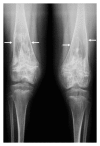Untangling the web of systemic autoinflammatory diseases
- PMID: 25132737
- PMCID: PMC4124206
- DOI: 10.1155/2014/948154
Untangling the web of systemic autoinflammatory diseases
Abstract
The innate immune system is involved in the pathophysiology of systemic autoinflammatory diseases (SAIDs), an enlarging group of disorders caused by dysregulated production of proinflammatory cytokines, such as interleukin-1β and tumor necrosis factor-α, in which autoreactive T-lymphocytes and autoantibodies are indeed absent. A widely deranged innate immunity leads to overactivity of proinflammatory cytokines and subsequent multisite inflammatory symptoms depicting various conditions, such as hereditary periodic fevers, granulomatous disorders, and pyogenic diseases, collectively described in this review. Further research should enhance our understanding of the genetics behind SAIDs, unearth triggers of inflammatory attacks, and result in improvement for their diagnosis and treatment.
Figures



References
-
- Drenth JPH, Van Der Meer JWM. The inflammasome—a linebacker of innate defense. New England Journal of Medicine. 2006;355(7):730–732. - PubMed
-
- Obici L, Merlini G. Amyloidosis in autoinflammatory syndromes. Autoimmunity Reviews. 2012;12(1):14–17. - PubMed
-
- Lidar M, Livneh A. Familial mediterranean fever: clinical, molecular and management advancements. Netherlands Journal of Medicine. 2007;65(9):318–324. - PubMed
Publication types
MeSH terms
Substances
LinkOut - more resources
Full Text Sources
Other Literature Sources
Medical

